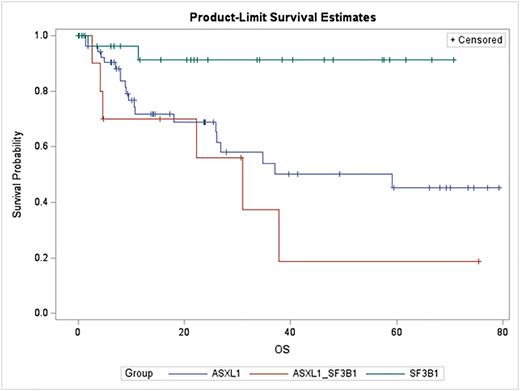Abstract
Introduction: Somatic mutations in the ASXL1 gene (additional sex combs like 1) are frequently observed in myeloid malignancies, including Clonal cytopenia of unknown significance (CCUS), myelodysplastic syndrome (MDS), myeloproliferative neoplasm (MPN), MDS/MPN, and acute myeloid leukemia (AML), and have been found to be independent predicative factor for poor overall survival. Mutations in SF3B1 (Splicing factor 3B subunit 1) were also frequently detected in the above hematopoietic disorders. It represents distinct molecular and clinical patient groups and shows particular association with ringed sideroblasts. Most studies have associated SF3B1 mutations with good clinical prognosis.
Both ASXL1 and SF3B1 mutations have been reported to frequently coexist with the mutations in other genes. Co-mutation of ASXL1 with SF3B1 is less frequent and has even been reported to be mutually exclusive by some authors. There are very few and contradictory reports about the clinical significance of co-existing ASXL1 and SF3B1 mutations, which is the goal of this study. Previous studies were also confounded by patients with mutations in some other genes.
Method: We identified 175 patients with only ASXL1 mutations, only SF3B1 mutations, or only ASXL1/SF3B1 co-mutations from our database of 8285 patients with NextGen sequencing (NGS) results, to study and compare their clinical features and outcomes. Baseline characteristics and other somatic mutation distribution were compared by chi square (categorical variables) and t-test (continuous variables). Overall survival was calculated using the Kaplan-Meier method log-rank test.
Results: Approximately 8285 patients with diagnosed or suspected myeloid neoplasm were tested by NGS. There were1515 patients with ASXL1 mutations with or without other genes mutated, and 583 patients with SF3B1 mutations with or without other genes mutated. There were also 97 patients with concurrent ASXL1 and SF3B1 mutations, most with additional genes mutated. Out of these patients, we identified 69 patients with only ASXL1 mutations (ASXL1 group), 89 patients with only SF3B1 mutations (SF3B1 group), and 17 patients with only ASXL1 plus SF3B1 mutations (ASXL1/SF3B1 group). The median age of ASXL1 group (69) was much younger than SF3B1 (76) and ASXL1/SF3B1 group (p values 0.01208 and 0.0001, respectively). The female to male ratios were similar among these groups. ASXL1 mutations were more frequent in AML and CCUS (22.47% and 33.71%) than ASXL1/SF3B1 (11.76% and 0%) and SF3B1 (1.45% and 7.25%) (p values < 0.003) mutations. On the contrary, SF3B1 and ASXL1/SF3B1 mutations were more frequent in MDS patients (75.36% and 64.71%) than ASXL1 mutations. In MDS/MPN, ASXL1/SF3B1 mutations (23.53%) were more frequent than SF3B1 (15.94%) and ASXL1 mutations (5.62%, p value 0.03513). The three groups of patients showed similar cytogenetic changes, with similar percentages of patients with normal karyotype, del(5q), del(7/7q), del(17p/TP53), del(20q), or trisomy 8. Finally, we compared the overall survival of the three groups of patients with normal karyotype by Kaplan-Meier survival analysis. As expected, ASXL1 group showed worse overall survival than SF3B1 group with a hazard ratio of 5.834 (p value 0.0175). However, it is interesting to found that ASXL1/SF3B1 group showed poorer overall survival than both SF3B1 and ASXL1 groups with a hazard ratio of 9.840 (p value 0.0052) (Figure 1).
Conclusion: Co-existing ASXL1 and SF3B1 mutations carried worse outcome than ASXL1 or SF3B1 mutation alone, likely due to abnormalities in both epigenetic regulatory pathway and RNA splicing pathway.
Disclosures
Hussaini:Adaptive Biotechnologies: Consultancy, Membership on an entity's Board of Directors or advisory committees, Speakers Bureau; Amgen: Consultancy, Membership on an entity's Board of Directors or advisory committees, Speakers Bureau; Aptitude Health: Consultancy, Membership on an entity's Board of Directors or advisory committees, Speakers Bureau; Blueprint Oncology: Consultancy, Membership on an entity's Board of Directors or advisory committees, Speakers Bureau; Celgene: Consultancy, Membership on an entity's Board of Directors or advisory committees, Speakers Bureau; Decibio: Consultancy, Membership on an entity's Board of Directors or advisory committees, Speakers Bureau; Diaceutics: Consultancy, Membership on an entity's Board of Directors or advisory committees, Speakers Bureau; Guidepoint: Consultancy, Membership on an entity's Board of Directors or advisory committees, Speakers Bureau; Seattle Genetics: Consultancy, Membership on an entity's Board of Directors or advisory committees, Speakers Bureau; Stemline: Consultancy, Membership on an entity's Board of Directors or advisory committees, Speakers Bureau; Tegus: Consultancy, Membership on an entity's Board of Directors or advisory committees, Speakers Bureau; Janssen: Consultancy, Membership on an entity's Board of Directors or advisory committees, Speakers Bureau; BMS: Consultancy, Membership on an entity's Board of Directors or advisory committees, Speakers Bureau.
Author notes
Asterisk with author names denotes non-ASH members.


This feature is available to Subscribers Only
Sign In or Create an Account Close Modal